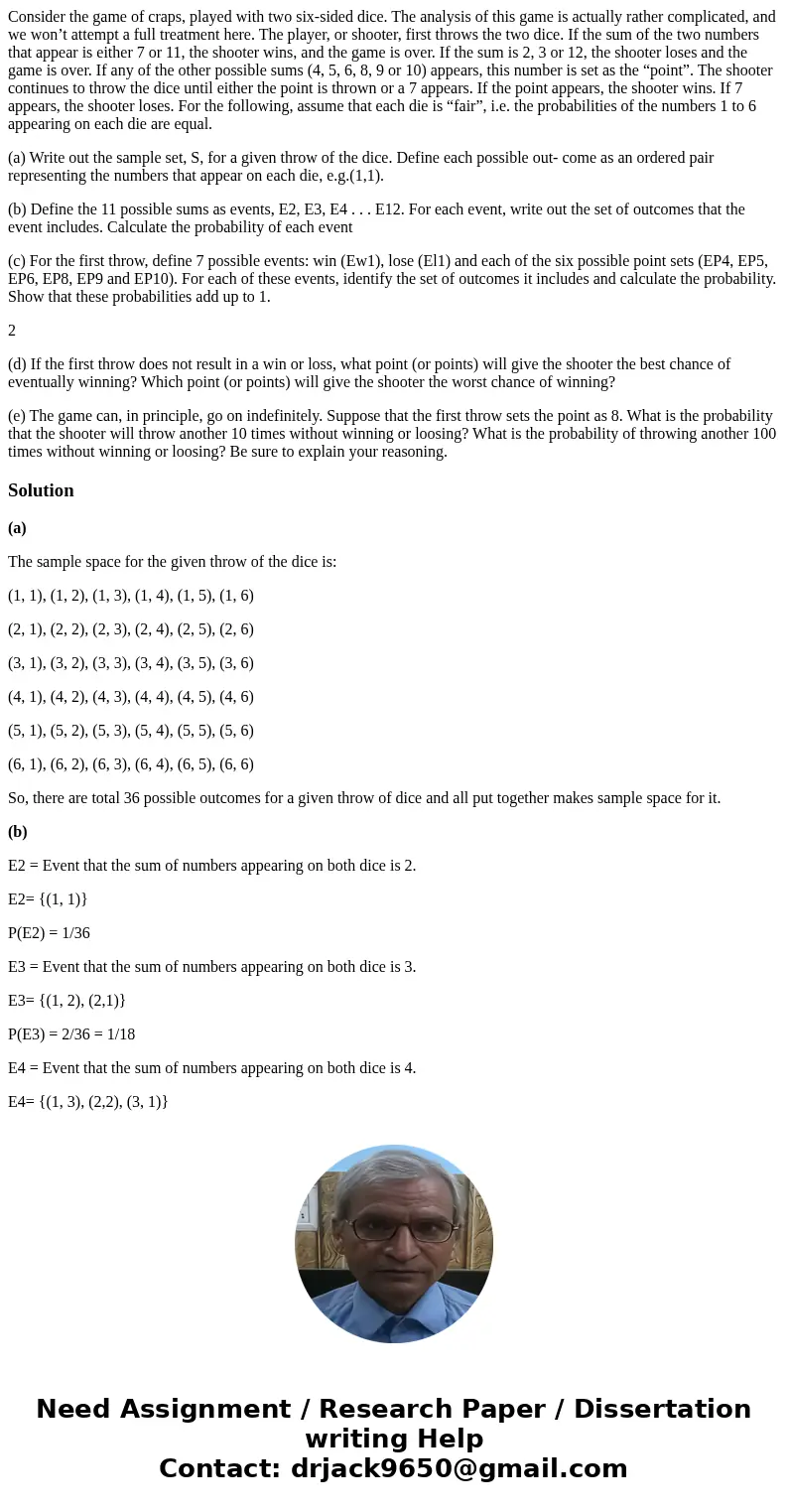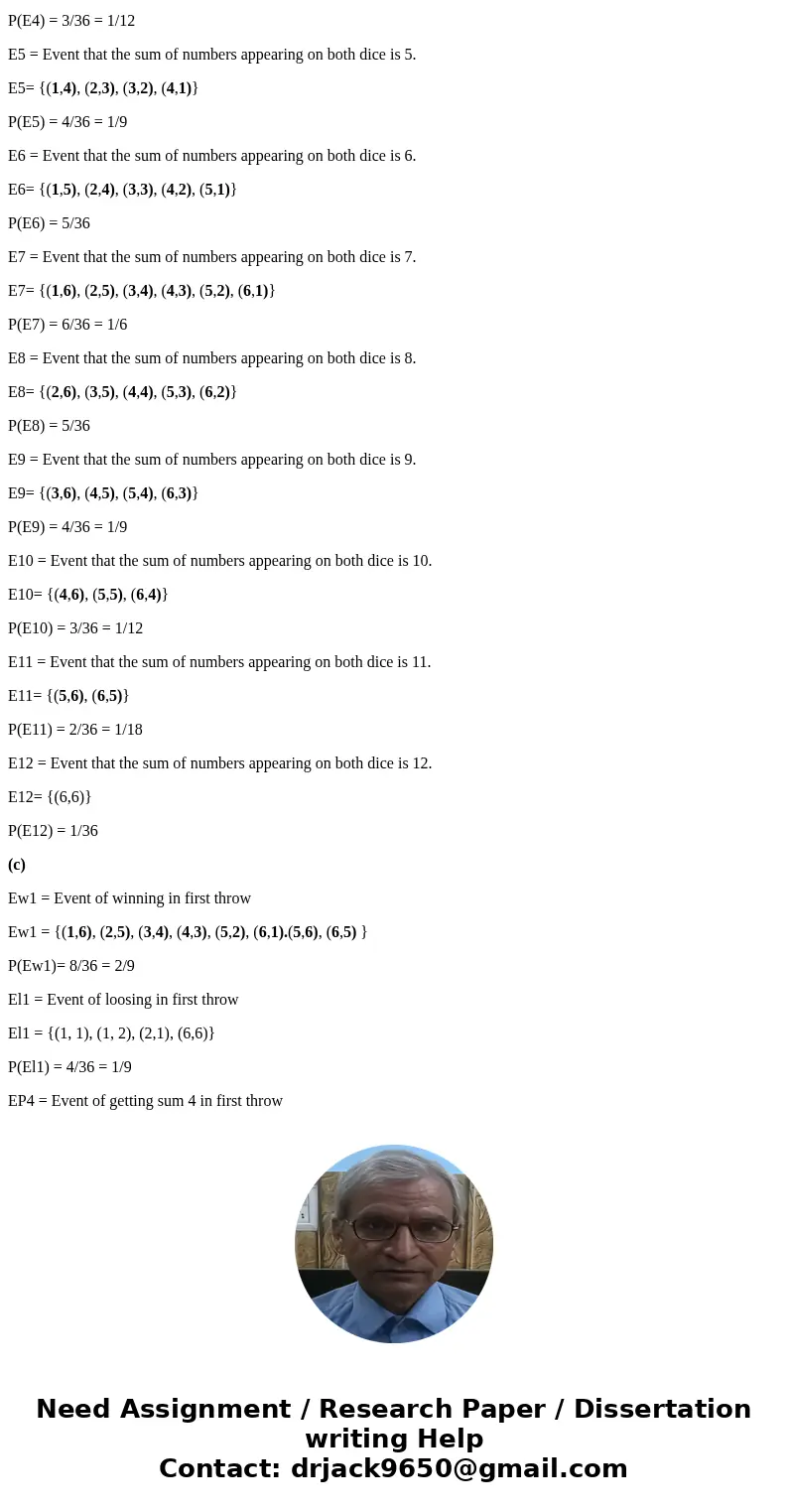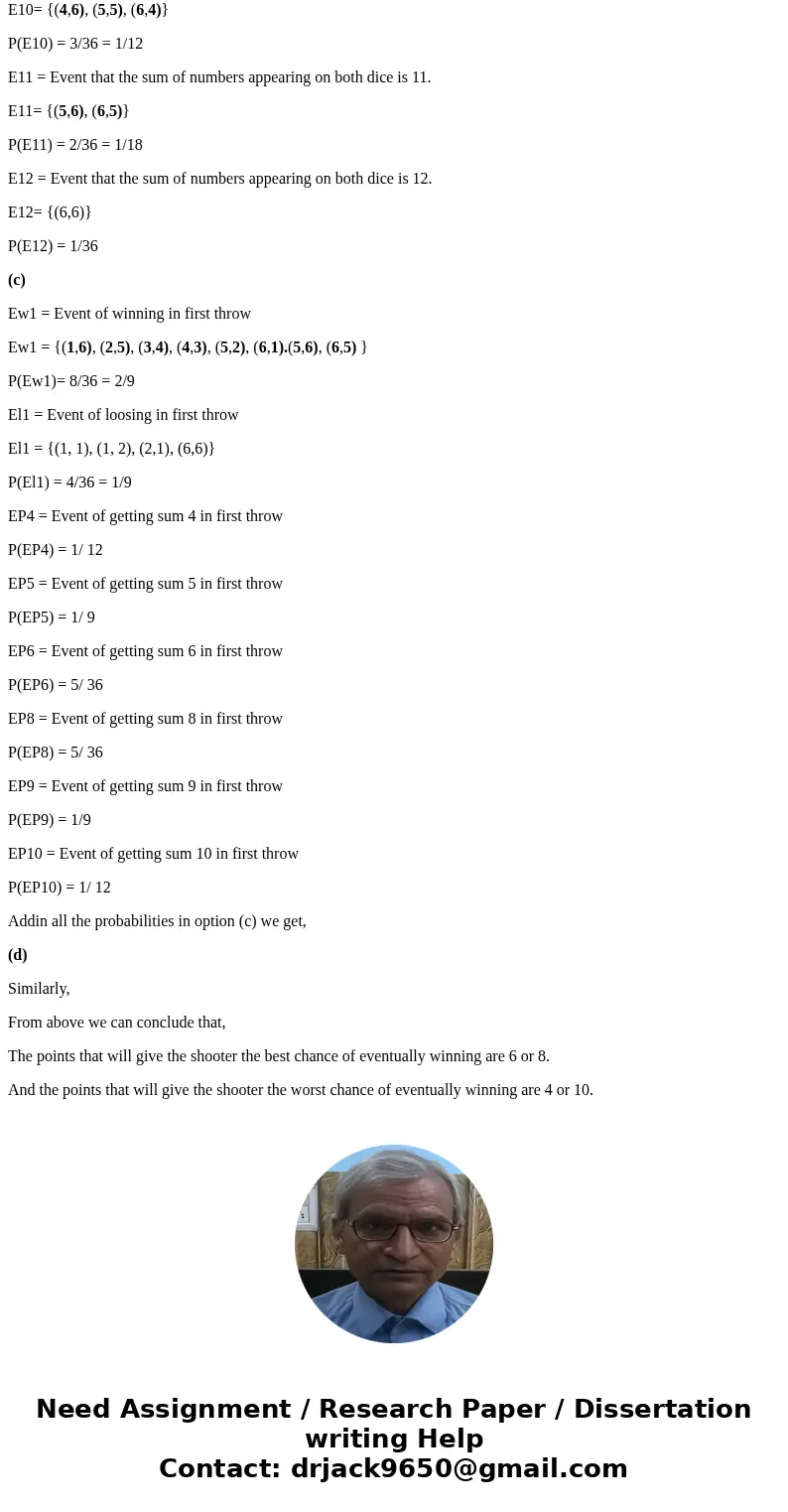Consider the game of craps played with two sixsided dice The
Consider the game of craps, played with two six-sided dice. The analysis of this game is actually rather complicated, and we won’t attempt a full treatment here. The player, or shooter, first throws the two dice. If the sum of the two numbers that appear is either 7 or 11, the shooter wins, and the game is over. If the sum is 2, 3 or 12, the shooter loses and the game is over. If any of the other possible sums (4, 5, 6, 8, 9 or 10) appears, this number is set as the “point”. The shooter continues to throw the dice until either the point is thrown or a 7 appears. If the point appears, the shooter wins. If 7 appears, the shooter loses. For the following, assume that each die is “fair”, i.e. the probabilities of the numbers 1 to 6 appearing on each die are equal.
(a) Write out the sample set, S, for a given throw of the dice. Define each possible out- come as an ordered pair representing the numbers that appear on each die, e.g.(1,1).
(b) Define the 11 possible sums as events, E2, E3, E4 . . . E12. For each event, write out the set of outcomes that the event includes. Calculate the probability of each event
(c) For the first throw, define 7 possible events: win (Ew1), lose (El1) and each of the six possible point sets (EP4, EP5, EP6, EP8, EP9 and EP10). For each of these events, identify the set of outcomes it includes and calculate the probability. Show that these probabilities add up to 1.
2
(d) If the first throw does not result in a win or loss, what point (or points) will give the shooter the best chance of eventually winning? Which point (or points) will give the shooter the worst chance of winning?
(e) The game can, in principle, go on indefinitely. Suppose that the first throw sets the point as 8. What is the probability that the shooter will throw another 10 times without winning or loosing? What is the probability of throwing another 100 times without winning or loosing? Be sure to explain your reasoning.
Solution
(a)
The sample space for the given throw of the dice is:
(1, 1), (1, 2), (1, 3), (1, 4), (1, 5), (1, 6)
(2, 1), (2, 2), (2, 3), (2, 4), (2, 5), (2, 6)
(3, 1), (3, 2), (3, 3), (3, 4), (3, 5), (3, 6)
(4, 1), (4, 2), (4, 3), (4, 4), (4, 5), (4, 6)
(5, 1), (5, 2), (5, 3), (5, 4), (5, 5), (5, 6)
(6, 1), (6, 2), (6, 3), (6, 4), (6, 5), (6, 6)
So, there are total 36 possible outcomes for a given throw of dice and all put together makes sample space for it.
(b)
E2 = Event that the sum of numbers appearing on both dice is 2.
E2= {(1, 1)}
P(E2) = 1/36
E3 = Event that the sum of numbers appearing on both dice is 3.
E3= {(1, 2), (2,1)}
P(E3) = 2/36 = 1/18
E4 = Event that the sum of numbers appearing on both dice is 4.
E4= {(1, 3), (2,2), (3, 1)}
P(E4) = 3/36 = 1/12
E5 = Event that the sum of numbers appearing on both dice is 5.
E5= {(1,4), (2,3), (3,2), (4,1)}
P(E5) = 4/36 = 1/9
E6 = Event that the sum of numbers appearing on both dice is 6.
E6= {(1,5), (2,4), (3,3), (4,2), (5,1)}
P(E6) = 5/36
E7 = Event that the sum of numbers appearing on both dice is 7.
E7= {(1,6), (2,5), (3,4), (4,3), (5,2), (6,1)}
P(E7) = 6/36 = 1/6
E8 = Event that the sum of numbers appearing on both dice is 8.
E8= {(2,6), (3,5), (4,4), (5,3), (6,2)}
P(E8) = 5/36
E9 = Event that the sum of numbers appearing on both dice is 9.
E9= {(3,6), (4,5), (5,4), (6,3)}
P(E9) = 4/36 = 1/9
E10 = Event that the sum of numbers appearing on both dice is 10.
E10= {(4,6), (5,5), (6,4)}
P(E10) = 3/36 = 1/12
E11 = Event that the sum of numbers appearing on both dice is 11.
E11= {(5,6), (6,5)}
P(E11) = 2/36 = 1/18
E12 = Event that the sum of numbers appearing on both dice is 12.
E12= {(6,6)}
P(E12) = 1/36
(c)
Ew1 = Event of winning in first throw
Ew1 = {(1,6), (2,5), (3,4), (4,3), (5,2), (6,1).(5,6), (6,5) }
P(Ew1)= 8/36 = 2/9
El1 = Event of loosing in first throw
El1 = {(1, 1), (1, 2), (2,1), (6,6)}
P(El1) = 4/36 = 1/9
EP4 = Event of getting sum 4 in first throw
P(EP4) = 1/ 12
EP5 = Event of getting sum 5 in first throw
P(EP5) = 1/ 9
EP6 = Event of getting sum 6 in first throw
P(EP6) = 5/ 36
EP8 = Event of getting sum 8 in first throw
P(EP8) = 5/ 36
EP9 = Event of getting sum 9 in first throw
P(EP9) = 1/9
EP10 = Event of getting sum 10 in first throw
P(EP10) = 1/ 12
Addin all the probabilities in option (c) we get,
(d)
Similarly,
From above we can conclude that,
The points that will give the shooter the best chance of eventually winning are 6 or 8.
And the points that will give the shooter the worst chance of eventually winning are 4 or 10.



 Homework Sourse
Homework Sourse